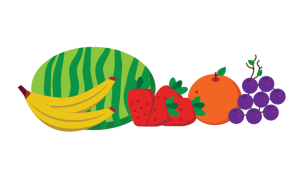About OER Development in Pressbooks
Adaptation Projects
Adapted from Fanshawe OER Design Studio
Two common types of OER projects that are not just “creating a new resource” include adaptations and collections. An adaptation is edits an existing work to create a new original copyrighted work. A collection is the assembly of separate and independent works into a collective whole (similar to a course packet or reader). These two types are discussed more below.
Adaptation
 The term adaptation is commonly used to describe the process of making changes to an existing work. We can also replace “adapt” with revise, modify, alter, customize, or any other synonym that describes the act of making a change.
The term adaptation is commonly used to describe the process of making changes to an existing work. We can also replace “adapt” with revise, modify, alter, customize, or any other synonym that describes the act of making a change.
This concept can be illustrated with a smoothie. Individual fruits are blended together and result in a new creation. The individual ingredients are no longer distinguishable. Nevertheless, attribution for the individual works is still required.
- a second edition of an existing work
- a screenplay based on a novel
- a book translated from one language to another
- a chapter in an open textbook that blends multiple open educational resources
Adapting open resources can be a good place to start for those who aren’t ready to create something from scratch, and there are many reasons why you might consider revising an existing work:
Potential Adaptations
Simple:
- Correct errors or inaccuracies
- Update the book with current information
- Add more media or links to other resources
- Use only a portion of the book while adding some of your own content
More complicated:
- Adjust for your course level (e.g. from Intro to Intermediate Microeconomics)
- Adapt for a different discipline (e.g. Math for Music Majors)
- Make the material more accessible (e.g. add captions or update tables)
- Add material contributed by students or material suggested by students (e.g. study notes, exercises, or applied examples)
Collection
 A collection is the assembly of separate and independent works into a collective whole. Each work in a collection retains its copyright protection and licensing terms, and each individual work in a collection must have attribution and licensing information.
A collection is the assembly of separate and independent works into a collective whole. Each work in a collection retains its copyright protection and licensing terms, and each individual work in a collection must have attribution and licensing information.
While an adaptation can be compared to a smoothie, a collection is more like a fruit salad. Each work — the strawberries, blackberries, apples, etc. — is part of the collection which is the fruit salad.
While a separate copyright exists for the collection, it only applies to the new contributions to the work such as the cover, the introduction, and the actual arrangement of the selected works (think about the fruit choices you might make for a fruit salad to create your own unique combination of flavors).
- a course packet containing foundational readings from several sources
- poetry anthologies with excerpts from various authors
- an album compilation of ’80s pop hits
As with adaptations, the licensing of a collection must be compatible with the copyrights and licenses of the individual works. The license for the collection does not alter the licenses for the works in the collection. For more information, consult the Creative Commons FAQs.
“Creative Commons: Understanding Adaptations & Collections” from Creative Commons Libguide by the College of Coastal Georgia is licensed under an Attribution-NonCommercial-ShareAlike 4.0 International License
“1. Definition of Adapt” & “2. Reasons to Adapt an Open Textbook” from Adaptation Guide by BCcampus is licensed under a Creative Commons Attribution 4.0 International License, except where otherwise noted.

